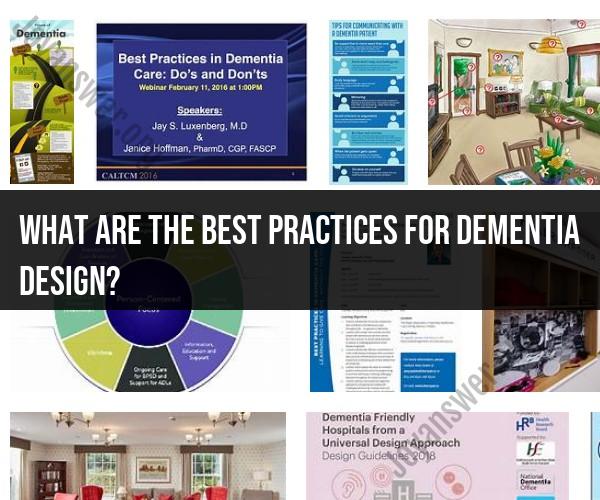What are the best practices for dementia design?
Designing spaces that are dementia-friendly is crucial for improving the quality of life and well-being of individuals living with dementia. These best practices aim to create environments that promote comfort, safety, and independence for people with dementia while minimizing confusion and anxiety. Here are some key best practices for dementia-friendly design:
Clear and Intuitive Layout:
- Use a simple and intuitive layout with clear paths and minimal visual clutter. Avoid long hallways and dead-end corridors.
- Ensure that common areas, bedrooms, bathrooms, and dining areas are easily accessible and identifiable.
Color and Contrast:
- Use color and contrast to highlight key features and provide visual cues. For example, use contrasting colors for doorways, handrails, and furniture to make them stand out.
- Minimize the use of patterned flooring, which can be confusing for individuals with dementia.
Lighting:
- Provide ample natural light and supplement it with well-placed artificial lighting.
- Ensure even lighting throughout the space to minimize shadows and glare.
- Use motion sensor lights in common areas and corridors to enhance safety.
Wayfinding and Signage:
- Implement clear and simple signage with easily recognizable symbols and words.
- Include directional signs to guide individuals to essential areas like bathrooms and dining rooms.
Furniture and Furnishings:
- Choose comfortable, easy-to-maintain furniture with rounded edges to prevent injuries.
- Avoid reflective surfaces on furniture, as they can be disorienting.
- Arrange furniture to create social and conversation areas that promote interaction.
Safety Features:
- Install safety features such as grab bars, non-slip flooring, and handrails in bathrooms and high-traffic areas.
- Use contrasting color strips on steps or changes in flooring level to prevent tripping.
- Secure sharp objects or potentially harmful items out of reach.
Memory Aids:
- Incorporate memory aids like memory boxes or memory boards outside individual rooms to help residents recognize their space.
- Use familiar objects and personal items to create a sense of familiarity and comfort.
Quiet and Calm Spaces:
- Designate quiet spaces for relaxation and reduce noise levels in common areas.
- Incorporate elements like soothing colors, comfortable seating, and sensory gardens to create calming environments.
Supportive Technology:
- Implement technology solutions such as GPS tracking for residents who may wander, and smart home systems that can assist with reminders and safety alerts.
Inclusive Gardens and Outdoor Spaces:
- Design gardens and outdoor areas with accessible pathways, comfortable seating, and sensory elements like scented plants and wind chimes.
- Ensure these spaces are secure and offer shade during hot weather.
Flexible Spaces:
- Design spaces that can be easily adapted for different activities and group sizes.
- Provide spaces for both group activities and quiet, individual pursuits.
Staff Training:
- Train staff members in dementia care and the principles of dementia-friendly design to ensure they can provide appropriate support to residents.
Dementia-friendly design is a holistic approach that considers the physical environment, sensory experiences, and the individual needs of residents. It aims to create spaces that empower people with dementia to maintain their independence, reduce anxiety, and enhance their overall well-being. Collaborating with architects, designers, healthcare professionals, and caregivers can help ensure that dementia-friendly design best practices are effectively implemented in care facilities and homes.












